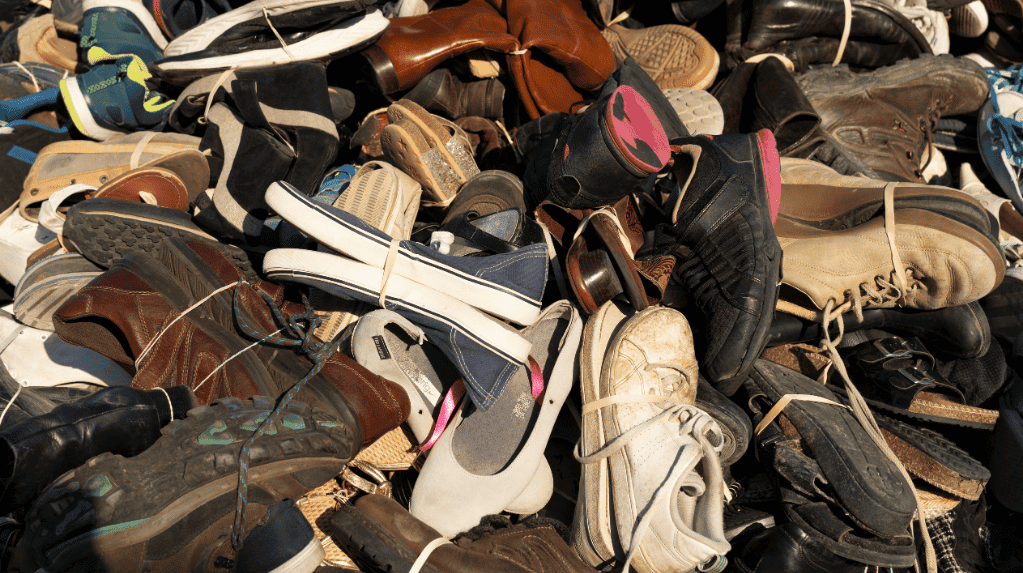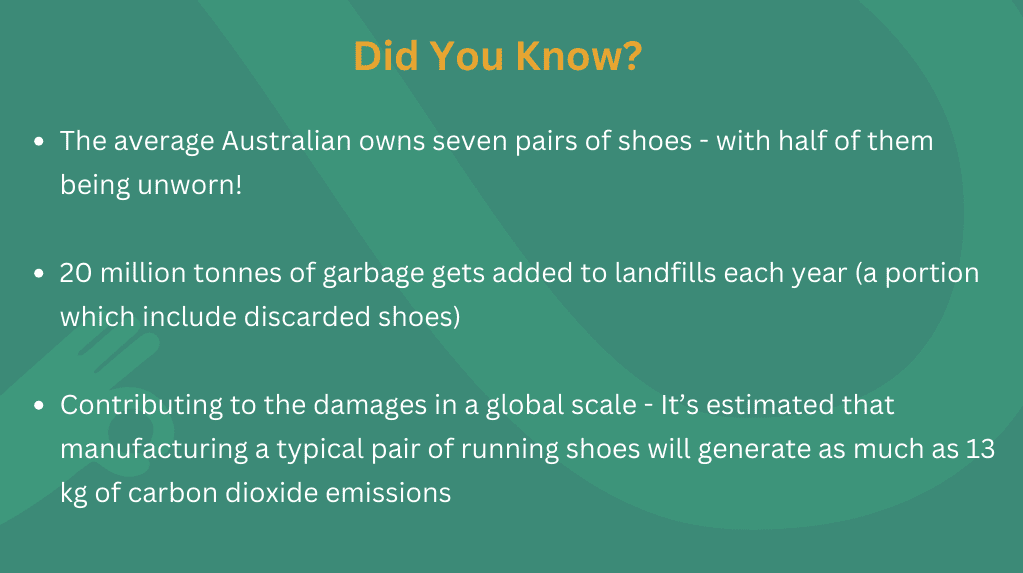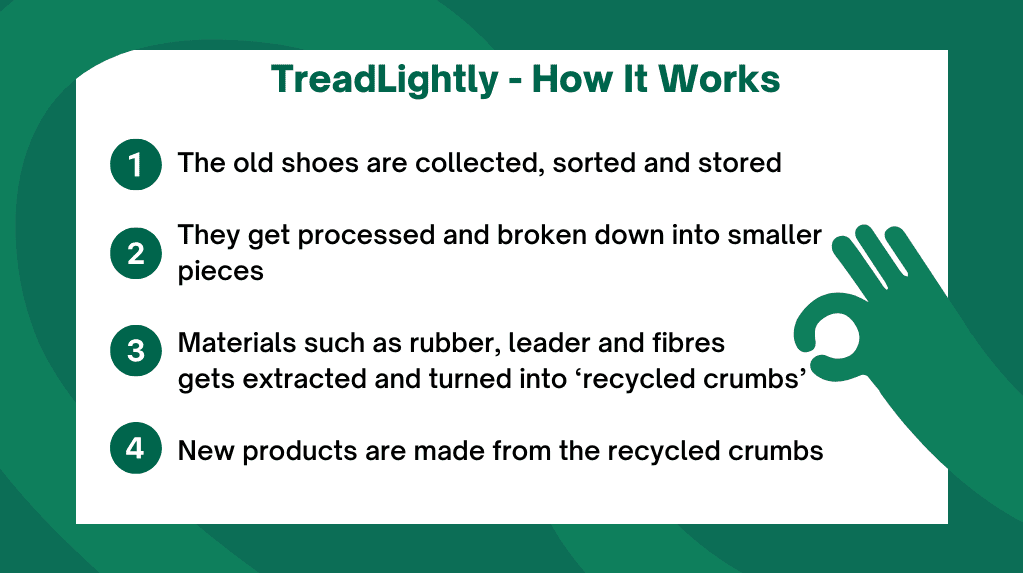
Australia’s love affair with footwear sees around 110 million pairs of new shoes make their way to our shoes each year. Unfortunately, less than 1% of all shoes in Australia are recycled, which means that the majority of worn out shoes end up in landfill or waste.
Whilst not all shoes can find a second owner or a new lease on life on the feet of the less fortunate, there are other steps that we can take to ensure that our once-loved footwear doesn’t add to the growing environmental problems faced in Australia.
To better understand the shoe recycling programs available in Australia and ensure that shoes don’t end up in landfill, this guide will explore the major recycling programs, retailers supporting recycling, and how you, as a consumer, play a pivotal role in mitigating shoe waste in Australia.
Table of Contents
- Australia’s Shoe Waste Problem
- The Importance of Shoe Recycling
- Shoe Recycling Options in Australia
- The Value of Sustainable Choices
Australia’s Shoe Waste Problem
Australian’s love shoes. In fact, research from TreadLightly found that the average Australian owns about seven pairs of shoes at any one time, with around half of these going unworn. The underutilisation of shoes is exacerbated by the fact that 99% of shoes will end up in landfills or at non-green garbage disposal facilities.
The lack of convenient recycling options, as well as a lack of education from retailers also contributes to the issue, despite the growing awareness that we, as a country, must improve our recycling practices.
According to the latest research from the University of Queensland, Australia adds around 20-million tonnes of garbage to landfills each year – a portion of which includes discarded shoes and clothing. Given that mass produced shoes contain largely non-recyclable materials, they can take up to 1,000 years to decompose and present a substantial long-term ecological threat.

The Importance of Shoe Recycling
Recycling shoes isn’t just about reducing waste and reducing landfill, it’s about saving our precious natural resources.
Manufacturing new shoes requires a lot of new materials with one recent study from the Massachusetts Institute of Technology indicating that the bulk of shoes’ carbon footprint comes from the manufacturing process.
It’s estimated that manufacturing a typical pair of running shoes will generate as much as 13 kg of carbon dioxide emissions – around the same energy that is required to power a 100-watt light bulb for an entire week. Research found that the manufacturing process, rather than the extraction of materials needed through the manufacturing, was responsible for around two-thirds of emissions. Some 57.5% of the world’s footwear production comes from China where coal is the predominant energy source in factories.
Further breaking down just how intensive the process of manufacturing a single pair of running shoes can be, research finds that the average shoe contains around 65 unique parts and requires over 360 steps to manufacture including sewing, cutting, moulding, and heating.
The level of detail and volume of unique, new materials that are required to manufacture a single pair of shoes highlights the complexities of fast-fashion and over-consumption of fashion in contributing to negative environmental outcomes.
Shoe Recycling Options in Australia
TreadLightly
TreadLightly is a joint partnership between the Australian Sporting Goods Association (ASGA) and the charity Save Our Soles which aims to reduce waste and promote shoe recycling practices that give unwanted sport and lifestyle footwear a second chance at life.
Understanding that one of the main problems with shoe recycling uptake in Australia is the limited access to drop off points, TreadLightly have partnered with a number of well-known retailers to provide collection boxes around the country. Participating TreadLightly shoe recycling network partners in Australia, include:
- Adidas
- Ascent
- Asics
- Brooks
- Decathlon
- Climbing Anchors
- Clarks
- Converse
- Drummond Gold
- Ecco
- FootMotion
- FJ
- Frakie4
- Globe
- Glue Store
- Hush Puppies
- Hype
- Implus
- Intersport
- JD Sports
- Macpac
- Merrell
- Mizuno
- New Balance
- Nike
- Platypus
- Puma
- Rebel Sport
- Reebok
- RM Williams
- Shoes & Sox
- Shoe Warehouse
- Sports Power
- The Athletes Foot
Participating branches from these retailers will provide collection boxes where old you can drop off old shoes for recycling. Not all branches will have collection points available at all times, so it’s worth calling before visiting to make sure that they have a collection box available when you visit.

Shoes Accepted by TreadLightly
- Lifestyle shoes
- Sports shoes
- Thongs and sandals
- Football/soccer boots
- Leather sports shoes
- Hiking shoes/boots
- Sneakers
- Trainers
- Running shoes
- Golf shoes
- Gumboots
Shoes Not Accepted by TreadLightly
- Formal shoes
- Business footwear
- Women’s dress shoes
- Men’s dress shoes
- High heels
- Steel cap boots
- Wedges
- Ballet flats
What Happens to Recycled Shoes with TreadLightly?
Footwear that is donated to TreadLightly directly or through partner retailers is sent to their recycling facility for sorting, breaking down, and processing. During this process, recyclable materials such as rubber, leather, and fibres are extracted. Reclaimed materials are used to manufacture new products such as gym mats, floors, and playgrounds across Australia.
Sell Your Used Shoes
For shoes that are still in good condition, selling them is another option worth considering. Facebook Marketplace, eBay, Gumtree are all popular platforms for selling second hand shoes that still have something to offer their next owner. A second owner not only extends the lifespan of the shoe, it also promotes a reuse culture that reduces the demand for new products.

Donate them to Charity
For shoes that still have something to offer their next owner, consider donating them to charity. The Red Cross, Salvation Army (Salvos), and other shops accept donations of pre-loved men’s, women’s, and children’s shoes – amongst other clothing items. Donations should be clean and in a condition that is sellable. That means shoes donated to charity shops in Australia should not be worn out, damaged – or generally in a condition that someone else would want to wear.
The Value of Sustainable Choices
The growing awareness in Australia for environmental and consumerism issues in Australia is driving change in the way that we buy and consume goods. Evident in the increasing demand for sustainable fashion choices and a perceptible push from retailers to provide eco-options for fashion, shoe recycling plays an important role in forming sustainable fashion habits.
Shoe recycling programs, while still in their infancy, provide a new avenue for Australian shoppers to participate in a circular economy. For greater buy-in, shoe recycling programs must continue to educate in the context of fast-fashion and overconsumption, while lamenting the importance of making sustainable choices in the way that we buy and consume.
As shoppers become more environmentally conscious and aware of heightened consumers, these choices can help to drive significant change in the fashion industry and put further pressure on retailers and manufacturers to promote product lines and recycling programs that are economically viable and socially responsible.